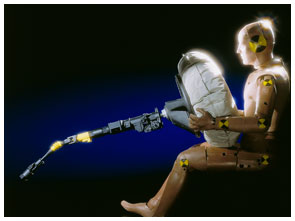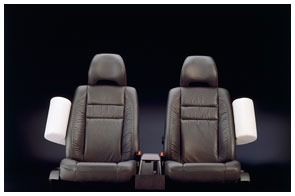Volvo Cars airbag celebrates 20 years
03 Jun 2007|1,702 views
 The first Volvo car to be equipped with an airbag left the assembly line in 1987 - and during the past 20 years Volvo Cars has continuously refined the airbag technology to enhance protection in both frontal and side impacts.
The first Volvo car to be equipped with an airbag left the assembly line in 1987 - and during the past 20 years Volvo Cars has continuously refined the airbag technology to enhance protection in both frontal and side impacts. Among the Volvo world firsts are both the seat-mounted side airbag and the Inflatable Curtain (IC).
The airbag is a standard feature since several years, but in the early days both the technology and its reliability created intense debate. At that time, many of these anxieties were justified.
"Getting an airbag to deploy is not a problem, but to make it deploy in exactly the right moment is," explains Lennart Johansson, section head at the Volvo Cars Interior Product Development department.
Started in the 1950s
 The first airbag solutions emerged already in the early 1950s. However, the technology was far from mature. One 1955 patent describes a system similar to today's, but with the significant exception that the driver himself had to deploy the bag by pressing a button™
The first airbag solutions emerged already in the early 1950s. However, the technology was far from mature. One 1955 patent describes a system similar to today's, but with the significant exception that the driver himself had to deploy the bag by pressing a button™ Another early debate focused on the use of a pyrotechnical charge to inflate the airbag with gas. These discussions concerned both the the handling of the explosives in the production plant and the potential dangers once they where installed in the car.
A controversial bill in the United States in 1984 speeded up the airbag development process. Focusing on the dangers of not using the safety belt, the bill stipulated that within three years new cars must be equipped with protective safety devices that didn't had to be activated by the occupants.
Co-operation with the safety belt
The airbag was quickly recognised as the best option. Many observers believed that it even would replace the three-point safety belt that was introduced by Volvo Cars already back in 1959.
However, Volvo successfully argued that the best safety result would be achieved by a co-operation between the safety belt system and the airbag technology.
"More airbags will not necessarily improve the overall safety level. It is important to regard the airbag as part of a systematic approach where the car's structure, the seat belts and the airbags interact to ensure optimum absorption of the collision forces in an accident," comments Lennart Johansson.
The airbag became later in the 90's standard equipment in the Volvo 850.
World firsts in side impact protection
In 1994, Volvo Cars took the technology further by introducing a side airbag that is integrated in the backrest of the seat, ready to help protect the chest in a side impact.
"We took a huge step forward by making the side airbag a part of our patented Side Impact Protection System that is integrated in the body structure. It took other carmakers a couple of years to catch up," says Lennart Johansson.
By then, it was already time for the next world first from Volvo Cars - the Inflatable Curtain (IC).
The IC is designed to enhance head protection for both front and rear seat occupants in a side impact. The roof-mounted version was introduced when the new Volvo S80 was launched in 1998 and is now a standard feature in all Volvo models except the C70.
Instead, the convertible is equipped with door-mounted inflatable curtains that are deployed upwards in a collision and remain inflated to provide protection if the car rolls over.
Volvo has taken this technology another step further in the recently introduced all-new Volvo V70 and XC70. Both models are equipped with Inflatable Curtains that have been extended by 60 millimetres to provide enhanced protection for children in the rear seat.
Extended IC
The airbag technology has changed a great deal since it was introduced 20 years ago - and Volvo has been one of the key players in the refinement process.
"Airbag performance has been improved significantly. Today's technology is much more adapted to the collision sequence and how occupant's are moved by the crash forces. Twenty years down the road, airbag technology is a vital part of our aim to build the safest cars in the world," explains Lennart Johansson.
 The first Volvo car to be equipped with an airbag left the assembly line in 1987 - and during the past 20 years Volvo Cars has continuously refined the airbag technology to enhance protection in both frontal and side impacts.
The first Volvo car to be equipped with an airbag left the assembly line in 1987 - and during the past 20 years Volvo Cars has continuously refined the airbag technology to enhance protection in both frontal and side impacts. Among the Volvo world firsts are both the seat-mounted side airbag and the Inflatable Curtain (IC).
The airbag is a standard feature since several years, but in the early days both the technology and its reliability created intense debate. At that time, many of these anxieties were justified.
"Getting an airbag to deploy is not a problem, but to make it deploy in exactly the right moment is," explains Lennart Johansson, section head at the Volvo Cars Interior Product Development department.
Started in the 1950s
 The first airbag solutions emerged already in the early 1950s. However, the technology was far from mature. One 1955 patent describes a system similar to today's, but with the significant exception that the driver himself had to deploy the bag by pressing a button™
The first airbag solutions emerged already in the early 1950s. However, the technology was far from mature. One 1955 patent describes a system similar to today's, but with the significant exception that the driver himself had to deploy the bag by pressing a button™ Another early debate focused on the use of a pyrotechnical charge to inflate the airbag with gas. These discussions concerned both the the handling of the explosives in the production plant and the potential dangers once they where installed in the car.
A controversial bill in the United States in 1984 speeded up the airbag development process. Focusing on the dangers of not using the safety belt, the bill stipulated that within three years new cars must be equipped with protective safety devices that didn't had to be activated by the occupants.
Co-operation with the safety belt
The airbag was quickly recognised as the best option. Many observers believed that it even would replace the three-point safety belt that was introduced by Volvo Cars already back in 1959.
However, Volvo successfully argued that the best safety result would be achieved by a co-operation between the safety belt system and the airbag technology.
"More airbags will not necessarily improve the overall safety level. It is important to regard the airbag as part of a systematic approach where the car's structure, the seat belts and the airbags interact to ensure optimum absorption of the collision forces in an accident," comments Lennart Johansson.
The airbag became later in the 90's standard equipment in the Volvo 850.
World firsts in side impact protection
In 1994, Volvo Cars took the technology further by introducing a side airbag that is integrated in the backrest of the seat, ready to help protect the chest in a side impact.
"We took a huge step forward by making the side airbag a part of our patented Side Impact Protection System that is integrated in the body structure. It took other carmakers a couple of years to catch up," says Lennart Johansson.
By then, it was already time for the next world first from Volvo Cars - the Inflatable Curtain (IC).
The IC is designed to enhance head protection for both front and rear seat occupants in a side impact. The roof-mounted version was introduced when the new Volvo S80 was launched in 1998 and is now a standard feature in all Volvo models except the C70.
Instead, the convertible is equipped with door-mounted inflatable curtains that are deployed upwards in a collision and remain inflated to provide protection if the car rolls over.
Volvo has taken this technology another step further in the recently introduced all-new Volvo V70 and XC70. Both models are equipped with Inflatable Curtains that have been extended by 60 millimetres to provide enhanced protection for children in the rear seat.
Extended IC
The airbag technology has changed a great deal since it was introduced 20 years ago - and Volvo has been one of the key players in the refinement process.
"Airbag performance has been improved significantly. Today's technology is much more adapted to the collision sequence and how occupant's are moved by the crash forces. Twenty years down the road, airbag technology is a vital part of our aim to build the safest cars in the world," explains Lennart Johansson.
Latest COE Prices
October 2025 | 2nd BIDDING
NEXT TENDER: 05 Nov 2025
CAT A$122,000
CAT B$131,889
CAT C$76,801
CAT E$136,000
View Full Results Thank You For Your Subscription.


















